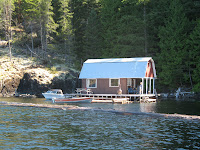Great Blue Heron

We had a visitor to our floating garden. It was a
Great Blue Heron. I most often see
herons on the breakwater of the Westview Marina. Those birds have distinctive black tufts on the back of their heads. This bird was missing the tuft, but otherwise very similar.

As he stood on a log, he cocked his head, probably watching fish that hide in the shadows. Suddenly, he took flight and passed right next to the sliding glass door of our cabin. You could hear his big wings whoosh through the air and his massive body gracefully glide past.
The
Great Blue Heron is the largest heron in Canada. An adult stands over 1 meter tall and weigh about 2.5 kilograms. That's a lot of bird! They forage for food in both coastal marine and freshwater environments. It is amazing how they can swallow large fish, reptiles, amphibians, even rodents in one big gulp. Here is an amazing video from
YouTube showing their massive swallowing ability.

Heron nesting areas are negatively affected by human interaction. It is important for us to preserve sites whenever possible. The
Great Blue Heron Nature Reserve in Chillawack, BC, is one example of what can be done. If you are familiar with herons, maybe you can give me some more information about the bird I saw. I look forward to your comments. -- Margy















































